Chlamydogobius eremius
Desert Goby
SynonymsTop ↑
Gobius eremius Zietz, 1896
Classification
Order: Perciformes Family: Gobiidae
Distribution
Type locality is ‘Coward Spring, in a small pool of water around an artesian well, central Australia’, and this species is endemic to the Lake Eyre drainage basin, South Australia.
It’s quite widely-distributed in southern and western parts of the basin, with a range extending southwards from the Neales River to Clayton Bore, west of the small town of Marree.
Habitat
Lake Eyre is a vast endorheic basin within which lies the lowest point in Australia at some 15 m BMSL. It only fills with water occasionally and when it does so forms the country’s largest salt lake.
C. eremius does not occur in the lake itself since no fishes are able to survive there, rather it inhabits isolated freshwater springs, flowing artesian bores (wells), and ephemeral waterholes where it tends to be associated with rocks and other submerged cover.
It’s capable of withstanding extreme variations in temperature (5-41°C/41-105-.8°F), pH (6.5-11.0), salinity (1-37.5 ppy) and dissolved oxygen (down to 0.8 ppm O2).
Although not an amphibious species, it can also survive in hypoxic conditions via a method of aerial respiration in which a bubble of air known as a buccal bubble is held against the roof of the mouth.
One example of a natural habitat is ‘The Bubbler’, an artesian mound spring comprising a central pool measuring a few metres across, plus a short overflow. It’s located a few kilometres away from the type locality in the Wabma Kadarbu Conservation Park and C. eremius is restricted to the overflow channel where it can be found among algae and marginal vegetation.
Maximum Standard Length
55 – 60 mm.
Aquarium SizeTop ↑
An aquarium with base measurements of 45 ∗ 30 cm or similar is sufficient to house a small group.
Maintenance
A sandy substrate is ideal though fine-grade gravel will also work, and in soft water areas coral sand or gravel may be required in order to maintain pH and hardness.
Other décor should consist of rocky structures and/or terracotta pipes or plant pots forming a network of crevices and caves.
Filtration should not be too strong but a degree of water movement is appreciated.
Marine salt can also be added at a rate of around 1 teaspoon per litre should you wish, though the fish will survive and breed in pure freshwater provided it isn’t too soft or acidic.
Water Conditions
Temperature: A value between 20 – 28 °C seems best for general care.
pH: 7.0 – 8.5
Hardness: 90 – 357 ppm
Diet
This species is an opportunistic omnivore by nature and an unfussy feeder in captivity. It will accept most dried foods but for best colour and condition should be offered meals of small live and frozen invertebrates such as Artemia, Daphnia, bloodworm, etc.
It also has a long, elaborately-coiled intestine suggesting a natural predilection for algae and other herbivorous matter, so we suggest offering greenstuffs on a regular basis.
Also take care not to overfeed as it’s something of a voracious eater.
Behaviour and CompatibilityTop ↑
Not an ideal community fish and in most cases is best maintained alone. If you do want to keep it with other fishes choose robust but peaceful species that dwell in the upper part of the water column and enjoy similar water conditions.
Males can be aggressive when in spawning condition and should be observed closely, especially in smaller aquaria, as they may attack and even kill conspecifics. For this reason it’s essential to provide sufficient cover (see ‘Maintenance and Decor’) so that subdominant or non-breeding individuals can seek shelter.
Sexual Dimorphism
Adult males have have relatively larger jaws than females and are much more colourful when in good condition, with a yellow to brownish body and bands of blue, black, and white pigment in the dorsal, caudal, anal and ventral fins.
Males can, however, change colour to a surprising extent and may appear very similar to females when newly-introduced to an aquarium, or in the presence of a dominant male or other stressor. If in doubt the fish can easily be sexed by examining the urogenital papillae, which in males is longer and more slender than in females.
Reproduction
This species deposits its eggs in crevices or caves and they’re defended aggressively by the male until hatching. In nature it’s been recorded to spawn when water levels are highest, between November and March, but in captivity will breed year-round.
In a well-structured set-up you may find a few fry survive alongside the parents but in most cases it’s best to spawn the fish in a separate tank, or have somewhere else to move the adults to once eggs have been laid.
Once in spawning condition males attempt to attract passing females via a courtship display involving jerky body movements and flaring of the dorsal and anal fins. A receptive female will eventually enter the spawning site and deposit the eggs on the roof, after which she is ejected.
At this point the female(s) are best-removed for their own safety while the male can be left in place to tend the eggs. Incubation is temperature-dependant to an extent but normally 10-17 days, and once the eggs have hatched the male can also be removed as he will prey on fry given the opportunity.
The fry settle directly onto the substrate with no pelagic larval phase as in some other gobies, and are large enough to accept Artemia nauplii or similarly-sized live foods immediately.
NotesTop ↑
This species is sometimes traded as C. eremius ‘gold’ or ‘gold desert goby’, but both names appear to refer to the natural form of the species.
The genus Chlamydogobius currently contains 6 described species, of which the relatively widespread C. ranunculus is also known in the aquarium hobby.
The grouping is often included in the subfamily Gobionellinae alongside genera such as Brachygobius, Mugilogobius, Pseudogobiopsis, Rhinogobius, Schismatogobius, and Stigmatogobius.
References
- Allen, G. R., H. Midgley, and M. Allen, 2002 - CSIRO: i-xiv + 1-394
Field guide to the freshwater fishes of Australia. - Symons, N., P. A. Svensson, and B. B. M. Wong, 2011 - PLoS ONE 6(6): e20576
Do Male Desert Gobies Compromise Offspring Care to Attract Additional Mating Opportunities? - Thompson, G. G., and P. C. Withers, 2002 - Comparative Biochemistry and Physiology Part A: Molecular & Integrative Physiology 131(4): 8717-879
Aerial and aquatic respiration of the Australian desert goby, Chlamydogobius eremius.

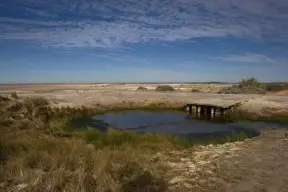
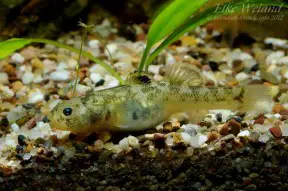
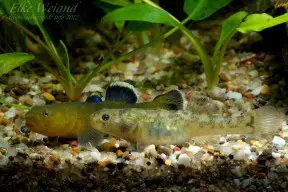
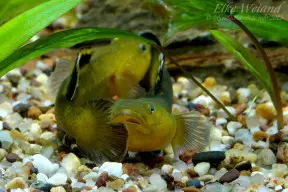
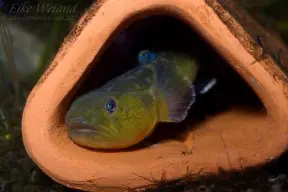
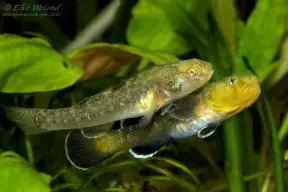
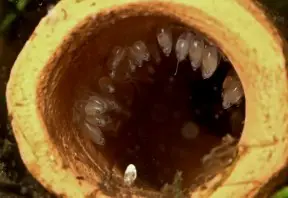
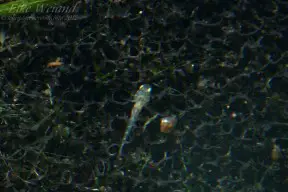
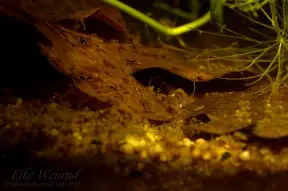

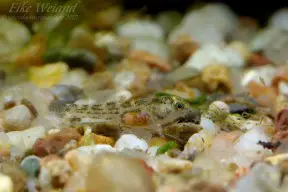
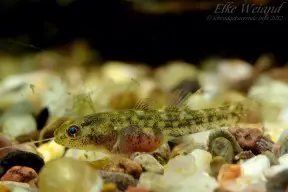
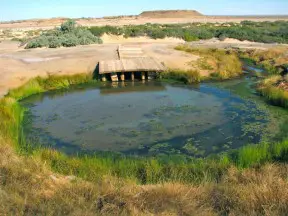
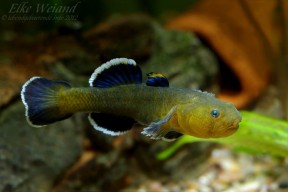
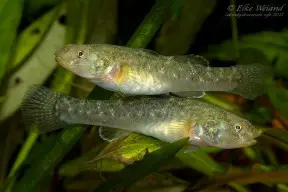
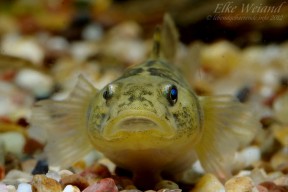
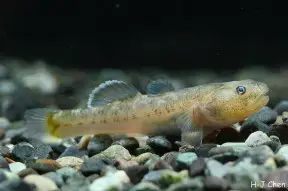
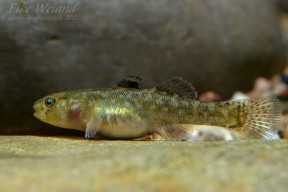


August 26th, 2013 at 1:45 pm
I currently have 3 remaining female gobies from a batch of eggs hatched Dec 2013, originally it was only 4 females and 1 male that grew to adulthood but a the male and a female died a few weeks ago. Sine then I have noticed 1 of the remaining females has gradually changed in colour and has taken on the appearance of a male and is now darker in the fins but not quite as vibrant blue as a male would be and without the white trim. She looks very different to the other two females who are still of a pale mottled sandy colour.
I’m sure she is still physiologically a female but is it possible for a female goby can transform to ‘appear’ like a male?
..and has there been any record of this happening?
Can supply photo if needed.